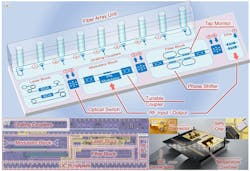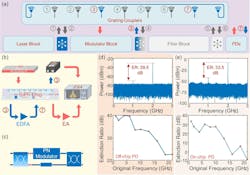Reconfigurable Silicon Microwave + Optical “Engine” Supports Analog Signal Processing
What you'll learn:
- How a single silicon chip was designed to be microwave and optical signal-processing engine.
- The various roles for which this engine can be reconfigured.
- The performance considerations that were overcome by this engine.
The quest continues for seamless integration of electro-optical functions on a single silicon chip, mainly due to the many likely applications as well as the obvious benefits of silicon-based technology. Pursuing this objective, a team composed of researchers from Belgium-based Ghent University and imec (a world-leading research and innovation hub) demonstrated a fully integrated microwave-photonics system that combines analog optical and microwave signal processing — and does so on a single silicon chip.
Their silicon-photonic engine chip integrates high-speed modulators, optical filters, photodetectors, as well as transfer-printed lasers, making it a compact, self-contained, and programmable solution for high-frequency signal processing. The key innovation in this new system is the combination of a reconfigurable modulator and a programmable optical filter, enabling efficient modulation and filtering of microwave signals while significantly reducing signal loss.
Flexible Engine for Microwave Photonic Systems
The resulting device has aspects of a field-configurable array capable of functioning as a flexible engine that can be used to construct different microwave photonic systems. The full programmability of the internal signal flow means that the chip can be used with any combination of optical and microwave input and output signals (Fig. 1). It can convert signals between the two domains as well as process them.
The researchers maintain it’s the first demonstration of a full black-box microwave/photonics process engine.
To allow for arbitrary use of both optical and microwave signals, they used optical switches between the individual blocks in the system that interface with optical fibers. As a result, the user was able to inject or extract light at every stage of the flow and even create fiber-based feedback loops.
Equipped with optical connections and supporting devices, their photonic chip can be used in various ways. It’s able to handle simple functions such as a tunable light source or a photodetector. And it can function as a high-speed transmitter or receiver, a tunable optical or microwave filter, a frequency converter, or a tunable opto-electronic oscillator (OEO).
>>Check out this TechXchange for similar articles and videos
The programmability of chip guarantees that its robust performance, and control and calibration of the entire chip, can be executed entirely in the electrical domain via optical monitors strategically placed throughout the chip.
Fabrication and Reconfiguration Details
The single-chip signal-processing engine, with a footprint of only 5 × 1.3 mm (not including the grating coupler array), provides a fully programmable filtering response for both optical and RF signals as well as generation and detection of electrical and optical signals. It’s built on imec’s standard silicon-photonics platform, which includes low-loss waveguides and passive components, high-speed modulators and detectors, and thermo-optic phase shifters for tuning the optical response.
To provide an integrated light source, the researchers incorporated an indium-phosphide (InP) optical amplifier on the chip using the microtransfer-printing technology developed by Ghent. They used this technology to integrate two tunable lasers into the photonic engine.
These tunable lasers cover a wavelength range from 1,507 to 1,575 nm, with a maximum output power of −3 dBm (measured at the output fiber) and an intrinsic linewidth of 45 kHz. In combination with on-chip tunable filter circuits, this allows the optical amplifier to function as a widely tunable laser, further enhancing the system’s versatility.
As seen in the silicon photonics chip and its corresponding block diagram (Fig. 2), the signal pipeline runs from the tunable lasers through the modulators (where the RF signal comes in) over the filter bank to the photodetectors and then to the RF output bondpads.
All elements on the chip are fully tunable with on-chip thermo-optic phase shifters. To enable arbitrary use of both optical and microwave signals, they introduced optical switches between the individual blocks in the system that interface with optical fibers. Thus, the user can inject or extract light at every stage of the flow and even create fiber-based feedback loops.
To test this device and assess its capabilities, they measured performance of various configurations up to 26 GHz, including:
- Optical linear filter
- Electrical-to-optical (E/O) filter
- Optical-to-electrical (O/E) filter
- Electrical-to-electrical (E/E) filter
- RF frequency multiplier and frequency doubling
- RF signal generation
- Optoelectronic oscillator
- Microwave photonic filtering based on dual-sideband modulation
Their detailed yet highly readable paper “Single-chip silicon photonic engine for analog optical and microwave signals processing,” published in Nature Communications, includes insight into principles, fabrication, design, tests, and results with associated graphs such as one for frequency doubling (Fig. 3). The paper also acknowledges inevitable or unavoidable shortcomings.
For example, the researchers note that the RF packaging of the photonic engine has relatively high crosstalk of about −60 dB. They also identify optical crosstalk issues due to reflections along the optical path as a potential problem, but add that the tunability of the system allowed them to compensate for most of these. Further, the paper discusses power dissipation, thermal considerations, thermal crosstalk, packaging, and many other aspects of their project.
>>Check out this TechXchange for similar articles and videos
About the Author

Bill Schweber
Contributing Editor
Bill Schweber is an electronics engineer who has written three textbooks on electronic communications systems, as well as hundreds of technical articles, opinion columns, and product features. In past roles, he worked as a technical website manager for multiple topic-specific sites for EE Times, as well as both the Executive Editor and Analog Editor at EDN.
At Analog Devices Inc., Bill was in marketing communications (public relations). As a result, he has been on both sides of the technical PR function, presenting company products, stories, and messages to the media and also as the recipient of these.
Prior to the MarCom role at Analog, Bill was associate editor of their respected technical journal and worked in their product marketing and applications engineering groups. Before those roles, he was at Instron Corp., doing hands-on analog- and power-circuit design and systems integration for materials-testing machine controls.
Bill has an MSEE (Univ. of Mass) and BSEE (Columbia Univ.), is a Registered Professional Engineer, and holds an Advanced Class amateur radio license. He has also planned, written, and presented online courses on a variety of engineering topics, including MOSFET basics, ADC selection, and driving LEDs.




